
The outer and broadest group represents people that have a general interest in genealogy. This would be a large portion of the general population. Surveys that ask broad questions about an interest in genealogy will encompass this group. It generally shows genealogy being as popular as gardening, which is viewed as one of the most popular pastimes in the world.
For those who have a general interest in ancestors, there is a subgroup that has knowledge of a family member (however distant) who researches ancestors. In the diagram above, this would be the second group.
The third group would be people who keep a copy of the family tree in their possession. These people have more than just than a passing interest in genealogy. They obviously feel that ancestors are important and they want to know more about them. They probably, however, have not done the actual ancestral research. They would most likely have gotten the family tree from a family member.
This brings us to the core group in genealogy: people who actively conduct ancestral research. It will be (by definition) the smallest group since not everyone in a family needs to do actual ancestral research.
By thinking of genealogy as a hierarchy of interests, it is much easier to understand conflicting survey and reports on the topic. Interest in the genealogy essentially ranges from the casual to the more serious. For the reminder of this article, we will concentrate on the core group: determining how many people actively conduct ancestral research.
How Many People Research Their Ancestors?
To answer the question of how many people actively conduct ancestral research, we are going to approach the issue from three different angles:
• We will provide a conceptual estimate of the maximum number of people who are likely to have conduct ancestral research.
• We will look at direct evidence to see how many people currently conduct genealogy research. We will do this by calculating how many people actually visit genealogy websites.
• We will determine if genealogy is growing by comparing the change in the number of genealogy website visits between 2012 and 2013.

